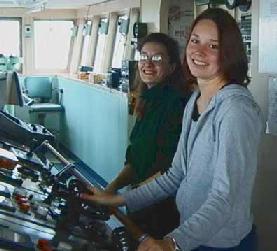WHAT'S NEW:
BACKGROUND:
Mission
Project Description
Cruise Plans:
Participants
Technology (ROV, ships, etc.)
Future Plans
Results:
1998 NeMO Cruise
Axial 1998 "Eruption"
Life At Sea Perspective
June 21, 22, 23, 24, 25, 26, 27, 28, 29, 30, July 1, 2, 3, 4, 5, 6, 7, 8, 9, 10, 11, 12, 13
July 13
Nicole Nasby
Oregon State University
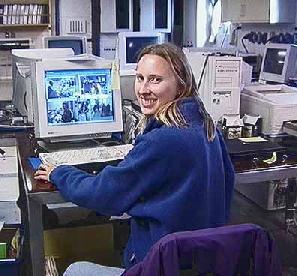 Well, I guess
I should introduce myself as the "woman behind the web" and no,
I'm not talking spiders. Although I am a scientist, my role on this cruise
has been more of a journalistic nature. I have been the photographer and
editor for the daily information that has been sent out on the web page.
I guess you could say I've gotten the "birds-eye" view of what goes on
around here. The things that have impressed me the most are the amount
of preparation and planning required to make a complex operation like
this run smoothly, as well as the amount of teamwork and collaboration
between scientists and engineers of varying disciplines. It was a treat
to see geologists, chemists and biologists working side by side and offering
discussions from their perspective. And of course I've learned that the
most important qualities to have on a cruise like this are patience and
flexibility! Mother Ocean is a powerful force and studying a volcano
1500 meters below the ocean surface is not a simple task. Overall
I am impressed with the NeMO program as a long
term monitoring site and with all of the of collaborative efforts that
are involved.
Well, I guess
I should introduce myself as the "woman behind the web" and no,
I'm not talking spiders. Although I am a scientist, my role on this cruise
has been more of a journalistic nature. I have been the photographer and
editor for the daily information that has been sent out on the web page.
I guess you could say I've gotten the "birds-eye" view of what goes on
around here. The things that have impressed me the most are the amount
of preparation and planning required to make a complex operation like
this run smoothly, as well as the amount of teamwork and collaboration
between scientists and engineers of varying disciplines. It was a treat
to see geologists, chemists and biologists working side by side and offering
discussions from their perspective. And of course I've learned that the
most important qualities to have on a cruise like this are patience and
flexibility! Mother Ocean is a powerful force and studying a volcano
1500 meters below the ocean surface is not a simple task. Overall
I am impressed with the NeMO program as a long
term monitoring site and with all of the of collaborative efforts that
are involved.
Aside from an overall passion for the ocean, my connection to this cruise is through Chief Scientist Bob Embley. I am presently a graduate student at Oregon State University in oceanography and am working on a Masters project with Dr. Embley looking at using high resolution sonar images to do a habitat assessment of Heceta bank (map left), a major fishing bank off the coast of Oregon. My background is in biology and I'm in the Marine Resource Management program at OSU. My interests are in marine conservation and management issues, and I am interested in the applications of using the sonar habitat assessment project for policy decisions in the areas of marine fisheries and marine protected areas. Originally the plan for this cruise was to spend the last few days at Heceta bank and do some exploring with ROPOS, but again, this is where flexibility comes in - we ended up needing all the remaining days to finish up the work at Axial.
July 12
Susan Merle
OSU/NOAA Vents Program
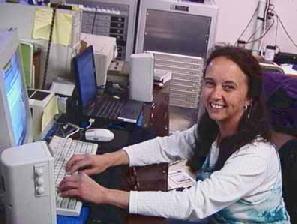 My name is Susan Merle.
I'm employed by Oregon State University as a research assistant for the
NOAA EOI Program. Almost 8 years ago I graduated from University
of Washington with a degree in Oceanography. Wow, how time flies when
youre having fun. I work in Newport,
Oregon at Hatfield Marine Science Center
with Bob Embley and Bill
Chadwick. Our main area of study is Axial
Volcano, although from time to time I've heard that we do venture
other places
in the Pacific. I haven't seen that yet. This is my second trip out to
Axial (the site of the NeMO Observatory) where the Vents Program and
its associates have been doing time series studies for over fifteen years.
Using ROPOS we are able to collect data that allows us to observe changes
in the chemistry, biology, and - my favorite - the geology of the volcano
and its vents.
My name is Susan Merle.
I'm employed by Oregon State University as a research assistant for the
NOAA EOI Program. Almost 8 years ago I graduated from University
of Washington with a degree in Oceanography. Wow, how time flies when
youre having fun. I work in Newport,
Oregon at Hatfield Marine Science Center
with Bob Embley and Bill
Chadwick. Our main area of study is Axial
Volcano, although from time to time I've heard that we do venture
other places
in the Pacific. I haven't seen that yet. This is my second trip out to
Axial (the site of the NeMO Observatory) where the Vents Program and
its associates have been doing time series studies for over fifteen years.
Using ROPOS we are able to collect data that allows us to observe changes
in the chemistry, biology, and - my favorite - the geology of the volcano
and its vents.
While at sea I perform several duties, the most time consuming of which is the 8 hours a day I spend navigating the sub. No, we dont actually drive the sub - just try to let the ROPOS crew and scientists know where we are on the seafloor. Paul Johnson gave you a good explanation of navigation earlier so I won't bore you with the details. Paul, Maia and myself split the day into 4 hour segments, each of us doing two 4 hours shifts per day. Bill Chadwick oversees all of our navigation endeavors. I also process the navigation after the dives, editing out bad "fixes" that can occur due to several factors (such as noise in the water, the hot water around the vents, "bounces" off features on the bottom, etc.). On a cruise like this lots of samples are collected, dive logs are kept, and instruments are deployed and recovered. My job as Bob Embley's assistant is to try to keep track of all the above and pull all that information together into a cruise report for all the scientists on board. This can be a challenge, at best. In Newport I perform many other tasks such as making maps, preparing figures for papers, posters for meetings, use GIS for database management, process bathymetry and sidescan sonar, and I'm sure theres a whole lot more I do - but right now I just can't remember it. Sort of a jack of all trades and a master of none.
The seas are kicking up tonight (predictions are for up to 40 knot winds and 17 foot seas) and reminding us that we are land creatures trying to study the processes under the sea, and just how difficult that can be at times. The wind if howling and I haven't really warmed up since we arrived almost a month ago. I love my job and my time at sea, but must admit I'm looking forward to heading back towards shore tomorrow. I hear that it is summer in Oregon, and I'm hoping to experience a bit of that before its over. Land ho!!
July 11
Christian Levesque
University of Quebec
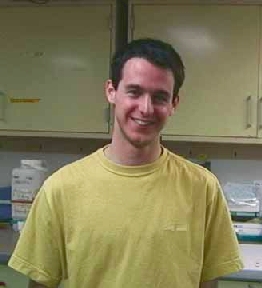 My name is Christian
Levesque and I am a Ph. D. student in biology at the University of Quebec
at Montreal (Canada). This is the third time I am going to sea to study
hydrothermal vents, and as such I think I must be one of the luckiest
students on Earth (or in Montreal, or at least in my neighbourhood!).
Back a few years ago, while I was wondering what I would do for a living,
the idea of doing scientific research was somewhat appealing to me, but
I certainly didn't expect that I was to spend weeks on the Pacific Ocean,
hundreds of kilometers from land, working with several other scientists
to understand these extremely fascinating systems deep down below. Hydrothermal
vent ecosystems are anything but boring; As a biologist, I am particularly
fascinated by the fact that, unlike other ecosystems on the planet, they
are supported by chemical energy rather than light. As these systems
are unique and recently discovered, we still know very little about the
biology and ecology of these extreme environments.
My name is Christian
Levesque and I am a Ph. D. student in biology at the University of Quebec
at Montreal (Canada). This is the third time I am going to sea to study
hydrothermal vents, and as such I think I must be one of the luckiest
students on Earth (or in Montreal, or at least in my neighbourhood!).
Back a few years ago, while I was wondering what I would do for a living,
the idea of doing scientific research was somewhat appealing to me, but
I certainly didn't expect that I was to spend weeks on the Pacific Ocean,
hundreds of kilometers from land, working with several other scientists
to understand these extremely fascinating systems deep down below. Hydrothermal
vent ecosystems are anything but boring; As a biologist, I am particularly
fascinated by the fact that, unlike other ecosystems on the planet, they
are supported by chemical energy rather than light. As these systems
are unique and recently discovered, we still know very little about the
biology and ecology of these extreme environments.
What I am particularly interested in is to understand what organisms eat at vents. As we are still discovering species that were previously unknown, we definitely don't know yet what the food chains look like. Understanding the feeding relationships between different species gives us insight into how they live together, why some species are most often found together and not with others, why and how the different populations of organisms evolve through time, how perturbations such as a new hot fluid source will affect the fauna, etc. Vent ecology is still a very young discipline, and these are among the first steps to try and understand a little better these ecosystems.
Since it is impossible to stay at a vent many hours and look close enough at animals to see what they actually eat and in what amount, the best way to elucidate feeding relationships is to use what we call tracers. Among those are stable isotopes of carbon, nitrogen and sulfur, and molecules like fatty acids. This might all seem a little complex, but its based on a simple idea: you are what you eat. These molecules or isotopes are found in certain amounts in each organism, and the animals that eat those will retain these molecules they took from their preys. Your cells are made of carbon, nitrogen, and molecules that come from the cereals, the carrots, the milk (and even the broccoli or spinach!) that you eat! Its exactly the same with palm worms or limpets at vents - although they probably don't have as much choice as we do in the grocery store!
July 10
Andy Graham
University of Washington
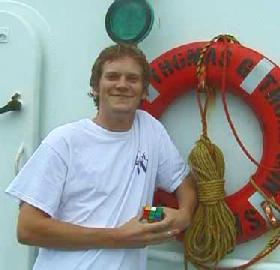 Up to this point the
cruise has been relatively stress-free for me as compared to some of the
other scientists on the cruise. I am a technician in a chemical oceanography
lab at the University of Washington, so unlike the other scientists and
graduate students on the ship I do not have a major project I am working
on. I am here to analyze the samples that we do get and others will use
the data I collect in their own projects.
Up to this point the
cruise has been relatively stress-free for me as compared to some of the
other scientists on the cruise. I am a technician in a chemical oceanography
lab at the University of Washington, so unlike the other scientists and
graduate students on the ship I do not have a major project I am working
on. I am here to analyze the samples that we do get and others will use
the data I collect in their own projects.
I am using a gas chromatograph to analyze vent fluid samples for dissolved hydrogen and methane gases. These gases are important in vent fluid chemistry because both can be used as sources of energy for microbes. By oxidizing either hydrogen or methane the microbes are able to grow and thrive. It is because of these, and other energy sources that the diverse biology found around vent site is able to survive without photosynthesis.
I graduated from the University of Washington with a B.S. in chemical oceanography last year and was offered this job as a "tech" by a professor of mine. I have found this job an invaluable learning experience in that I have been able to work and learn along side many top scientists in the field of hydrothermal vents. Plus, due to the experiences this job has offered me, I have decided to attend graduate school in oceanography. This is the second cruise I have been on as a "tech", the first was to the Southeast Pacific Rise where I was performing pretty much the same function as I am on this cruise.
Like most of the others on the cruise I have filled in the down time with movies, ping pong, and the Rubix cube that Maia brought along. I have gotten quite skillful at the cube, thanks to my master Maia, of course this is a skill I learned about 15 years too late since Rubix cubes aren't quite as poplar as they were back in the mid 1980s.
July 9
Kim Wallace
Canadian Scientific Submersible Facility
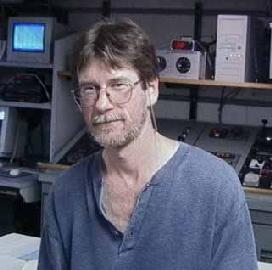 Its three in the morning.
I could see my breath if it wasn't raining so hard and the wind makes
a misery of working under a tarp stretched over the cage. Fluid-4 and
salt spray is keeping my hair in place. Im wet, tired and I'm grinning;
our ride is ready . However it may look from behind the yellow line, this
is the fun part.
Its three in the morning.
I could see my breath if it wasn't raining so hard and the wind makes
a misery of working under a tarp stretched over the cage. Fluid-4 and
salt spray is keeping my hair in place. Im wet, tired and I'm grinning;
our ride is ready . However it may look from behind the yellow line, this
is the fun part.
For the ROPOS guys taking this puppy to sea is the tangible expression of our ever-expanding technical aspirations. Here at Axial we have the opportunity to test our mettle, and that of the machine we have put together, against some of the most intense environmental stresses imaginable: on the hearth of a blast furnace at the bottom of the ocean. Most of the time we win.
Notice I can't say much without saying we. That's another reality out here. We are a team as close as any family. We are here to operate and service the vehicle, twenty four hours a day, for a month. Can you name six people that you could live and work with for that long without going crazy?
On the beach were dealing with budgets, schedules, suppliers, customs and, on a good day, design problems. At sea we leave a lot of that behind. This is where it all comes together. Its a little intense and a lot rewarding.
This is the fun part.
July 8
Leigh Evans
OSU/NOAA Vents Program
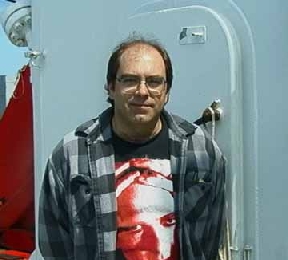 I'm on this expedition
to sample the fluids which emerge from vents and separate the gases from
them. These gases are sealed in glass ampoules for a number of chemical
analyses which will be done in laboratories on land. Aside from that I
test variations in the methods of sampling the vents.
I'm on this expedition
to sample the fluids which emerge from vents and separate the gases from
them. These gases are sealed in glass ampoules for a number of chemical
analyses which will be done in laboratories on land. Aside from that I
test variations in the methods of sampling the vents.
One of the analyses which I will be personally involved in performing is that of the helium isotopes, He3 and He4, in vent fluids. This is a gauge of the input of gases from the earth's magma into the vent system. The data are also used in comparison to other analyses of the vents such as the concentrations of iron or the amount of heat present. Sampling over a variation in geography and over time might tell us about increases or decreases in the volcano's activity, or its activity in a particular location. Other labs will analyze these samples for hydrogen and methane.
July 7
Paul Johnson
University of Hawaii
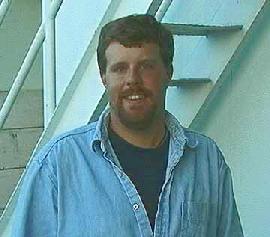 Aloha from the North
East Pacific Ocean. The first thing I must admit is that the cold grey
Pacific ocean which we are currently working in is quite a change from
the warm blue Pacific waters around Honolulu, Hawaii where I live. I work
as a marine geologist for the
Hawaii Mapping Research Group (HMRG) at the University of Hawaii.
HMRG specializes in the both the science and engineering behind designing,
building, running, and interpretation of data of systems that map the
ocean floor. My job at HMRG, whether we are working at the University
or out somewhere at sea, is to process the data from these system and
to then generate maps from this data.
Aloha from the North
East Pacific Ocean. The first thing I must admit is that the cold grey
Pacific ocean which we are currently working in is quite a change from
the warm blue Pacific waters around Honolulu, Hawaii where I live. I work
as a marine geologist for the
Hawaii Mapping Research Group (HMRG) at the University of Hawaii.
HMRG specializes in the both the science and engineering behind designing,
building, running, and interpretation of data of systems that map the
ocean floor. My job at HMRG, whether we are working at the University
or out somewhere at sea, is to process the data from these system and
to then generate maps from this data.
Before working at HMRG I worked for the Dr. Embley and Dr. Chadwick in Newport, Oregon as a Research Assistant doing work on the Juan de Fuca Ridge. So when they asked me if I wanted to come along, I jumped at the chance. I was especially intrigued about the opportunity of being able to do a comparison of the Hawaiian style volcanic features, which I have had the pleasure to watch form as the molten rock was erupted out of the earth, and the types of features we would find during our dives on this cruise.
My role on this cruise is as one of the three navigators. Using a network of transponders set out on the seafloor we are able to determine the location of ROPOS as it moves along the seafloor. We monitor the ROV's movement, determine the quality of the navigation that we are collecting, and relay information to both the ROPOS team and the bridge of the ship on where different vents or features are located. This turns out to be a pretty interesting role as you are involved with the some of the operations of the dive, instead of just being an observer. However, no matter how interesting it is, getting up for my first shift of the day at 3:30am is sometimes just a little bit too painful.
Today actually proved to be a very exciting days for me personally as I was involved with the small boat recovery of the rumbleometer which we freed from grips of the lava flow last night. If you have ever seen a small boat launch from a ship of this size, you would know that it is a pretty neat sight. You get into the boat on the level 2 deck of the ship, the boat then drops on a harness and descends something like 30 feet to the water below, where you then start up the engines and take off......pretty cool. Once on the water we had a spectacular view of the R/V Thompson with nothing but the Pacific around it (why, oh why, did I forget my camera). Our job in the small boat was to remove all of the loose lines and gear from the rumbleometer (after it made it to the surface), so that after we towed it back to the ship it would make pulling it out a whole lot easier. This turned out to be quite a bit of work as all of the lines were crossed and fouled on the top of the rumbleometer. After some pretty hard work of yanking and tugging on lines we had almost all of the lines either off the rumbleometer or secured. The rumbleometer was then lifted up on the deck of the ship using the crane, and we then zoomed in next to the ship and the entire small boat was picked up by the harness and hauled back up. All in all, a pretty great day.
July 6
Christina and Cheryl Ells
R/V Thompson
Sisters at Sea
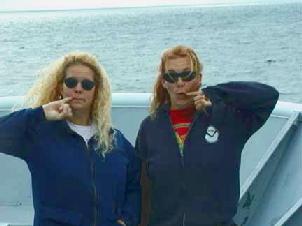 Christina
and Cheryl Ells have been going to Sea (on and off) over a period of thirteen
years before the ROPOS Cruise, Cheryl convinced her Sister to return to
Sea after a Seven Year hiatus to give them the chance to sail together.
Christina
and Cheryl Ells have been going to Sea (on and off) over a period of thirteen
years before the ROPOS Cruise, Cheryl convinced her Sister to return to
Sea after a Seven Year hiatus to give them the chance to sail together.
Christina:
Christina is a Licensed Massage Therapist with her own practice in
Seattle and thought a trip out to Sea would offer a nice little break.
Christina's position on the ship is "Galley Slave." She did bring her
massage table so as not to get out of touch!
Cheryl:
Cheryl, is an Able Bodied Seaman, who recently returned from a cruise
around the world with NOAA, to return once again to the Thompson. She is
saving money to return to school in the study of Naturopathy, Yoga and
Meditation.
July 5
Steve Scott and Naaznin Pastakia
University of Toronto

Naaznin Pastakia and Steve Scott are geologists from the
University of
Toronto
Naaznin:
Naaznin, who comes from
Bombay,
India, is working on her MSc thesis under the direction of two profs at
Toronto (so double-trouble!), Steve and his colleague Grant Ferris, a
biogeochemist specializing in metal precipitating bacteria.
Naaznin's research involves the role of bacteria in precipitating solids.
This process, called "biomineralization" is happening at Axial Volcano.
Bacteria in low temperature vents are concentrating mainly iron and silica
from the vent fluids onto their bodies. The iron is a semi-amorphous
oxyhydroxide called ferrihydrite (Fe5HO8.4H2O). On the seafloor, it looks
like
fluffy red stuff sitting in cracks and fissures on the surface of the
rocks and, in places, forms small mounds several centimeters high.
Naaznin is characterizing the composition and mineralogy of this
ferrihydrite. Analyses show that, besides iron and silica, ferrihydrite
also contains various other elements in minor (Mn, Mg, P) to trace (Ni,
Ba, Cu, Zn) amounts. In some ancient lava flows, bright red iron-rich
chert fills cracks and spaces around the pillows (pillows are bun shaped
features that are common in many lavas). Naaznin is attempting to
determine if the origin of this chert is the "fluffy red stuff" that we
are seeing so commonly at Axial Volcano.
Steve:
Steve is the Director of the
Scotiabank Marine Geology Research Laboratory.
He started rather late in the
marine business. "I spent the first 14 years since the completion of my
PhD at
Penn State University synthesizing metallic sulfide minerals and
trying to figure out how metallic ores formed", says Steve. "When I saw a
photo of a black smoker in
National Geographic magazine in 1979, I just
knew that some of the answers I was seeking were to be found in the
oceans." We had already understood that a particular kind of ore deposit
containing copper, zinc, lead, silver and gold formed on the ocean floor
but we were not sure of the process. Our marine studies, including those
at Axial Volcano, have demonstrated conclusively that
the minerals are
precipitated as metal sulfides from hot water that is spewed out onto the
sea floor through chimney-like structures. The
black billowing hot fluid
looks like smoke coming out of a stack in a dirty industrial process,
hence the term "black smoker". By studying modern analogs in todays
oceans, we've learned a lot about how ancient ores formed as long as 2.7
billion (yes, billion) years ago. It is also just dawning on us that some
of the seafloor deposits may be an economic resource themselves. The
deposits at Axial Volcano are far too small to be economic, even though
they are quite gold rich, but we know of other deposits that are as big as
mines on land.
Biomineralization is another thing that excites Steve. "It amazes me to
think that such tiny creatures as bacteria can concentrate such large
quantities of metals and other elements", says Steve. Given enough time,
can they create ore bodies? Can we use bacteria to remove pollutants from
water just like the bacteria around hydrothermal vents at Axial Volcano
are detoxifying their environment? Answers to these and other questions
may come out of Naaznins and Steves research.
Steve was one of three founders of the Canadian Scientific Submersible Facility that manages and operates the ROPOS remotely operated vehicle we are using in the NeMO program. "I drew the short straw and was made President", jokes Steve. Kim Juniper, who is also out here on NeMO, is the Secretary-Treasurer. The founders of the not-for-profit CSSF corporation are all academics who knew nothing about running a business but have learned fast. It is a lot of work but is necessary if the scientific community, of which Steve and Kim are a part, is to maintain access to this incredible machine that is our vehicle to inner space on the seafloor.
July 4
Marlene Le Bel and
Catherine Charpentier
University of Quebec
A labordage! Hi! My name is Marlene Le Bel and I'm one of the two French Canadian student researchers onboard the Thomas G. Thompson. Im a 23 years old woman who wants to travel and learn everything related to the ocean. I have a certificate in ecology and am in my second year as an undergraduate Biology student. I am currently working for Dr. Kim Juniper at University of Quebec at Montreal during the summer. Our first project is to map Cloud vent because it is so difficult to navigate underwater with the submersible and know exactly were we are even if we use high tech instruments. Mapping this site is also important because it is impossible to have an overview of the whole site when the water is cloudy with suspended particles due to the lack of light. Secondly, we will try to create another map (I hope so) of the vent Marker 33, a new site formed by lava flows of the 1998 eruption. A map of this area would be useful to the many scientists who wants to study here and follow its evolution year after year. To complete the mapping objective, we have to build mosaics with images that are digitized from video. To build mosaics and maps, well be using IP Lab Spectrum, Photoshop and Freehand software and a lot of patience. In order to get precise images, ROPOS pilots will have to position the camera specifically, so each image taken is kept at a constant angle and distance from the object. Stability of the platform (ROPOS) is a must for the best results. Finally, thanks to Dr. Juniper and NSERC undergraduate scholarship, this is my first experience on a research vessel I hope that it will not be my last one.
~ SEA you next time!~Marlene.
Hi ! Im Catherine Cat the kat (its better in English), (in French), I arrived in Montreal last February for this job and will stay until next September. I'm 28, (single, computer worker, no, its a French joke) from Brittany, little Brittany, in France (the "Bretons" colonized the planet, of course !!). I'm the third French scientist on this boat. Its a little difficult for me because I understand what people talk about, but very few words exit from my lips I try. And most important, Im not seasick, very surprising for a first cruise, but very important for my work!!!
I have a French Masters in Molecular Biology, animal and plant Physiology, and Microbiology. Im a molecular biologist but my baby is microbiology. Because Im a scientist, remember, here is a little about my research - I have worked on vents for 2 years now, first in France, in Prieurs team (Centre National de Recherche Scientifique - Roscoff, France), and now for Kim Juniper. I am working to qualify and quantify the micro-organisms which live at vents. These sorts of microbial communities (Archea and Bacteria) are so incredible. Thermophiles have an amazing mechanism developed for "adaptation" to high temperatures. They have very resistant DNA and proteins and a unique phospholipidic membrane which makes it resistant to metals and toxic products like arsenic, oxides etc. Its great, isn't it!
On this cruise I am extracting ATP (Adenosin-5-triphosphate) to determine the amount of bacterial viable biomass (living bacteria), because ATP disappears when bacteria are dead. I do lipid extractions for lab analysis which give me a lot of information like metabolic status, viable biomass (to replicate my direct extraction of ATP), and biomarkers of bacterial species in phospholipids. And to correlate this, I keep sub-samples for PCR (Polymerase Chain Reaction) to amplify the RNA 16S gene (a fragment of RNA), whose sequence is specific to each species. Its a very important experiment because its the first time that ATP has been extracted on vents.
On the other hand, we are like children in front of pictures of the abyss, and when the captain said "Whales off the bow ", or "dolphins off the stern" we all run.
And like Marlene - see you ok! Sea you later.
Et specialement pour nos francophonesavec les accents, sil vous plait Je ma'ppelle Catherine - Cat le chat : cela fait moins bien en francais quen anglais mais bon- je suis donc (fraichement) arrivee en fevrier a Montreal, ou je reste jusquen septembre prochain pour ce travail. Jai 28 ans, (celibataire, informaticienne, non je deconne..) je viens de Bretagne - les Bretons colonisent la planPte, si! Si! - en France. Je suis la troisieme francophone sur le bateau, et ce nest pas evident car je comprends de quoi ils parlent mais pas moyen de sortir trois mots alignJs, cela reste colle sur mes levres..enfin jessaie Et tres important, je nai pas le mal de mer, tres surprenant pour une premiere croisiere mais tres important pour mon boulot.
Le reste cest plutot scientifique, jessaie de quantifier et qualifier la biomasse viable des bacteries qui vivent pres et sur les sources hydrothermales sous-marines profondes, avec lextraction de l'ATP, des lipides et de l'ADN. Un scoop, cest la premiere fois au monde que lon fait de lextraction d'ATP sur les colonies bacteriennes des cheminees...Et cest moi qui laie fait..
Dun autre cote nous sommes comme des gamins, a baver devant les images des sites, ou encore a courir lorsque le capitaine nous informe quil y a des baleines, droit devant, ou pour assister au show des dauphins. Allez salut..
La joke du sea you later marche quand meme ???
Catherine Charpentier
July 3
Mike Dempsey
Canadian Scientific Submersible Facility
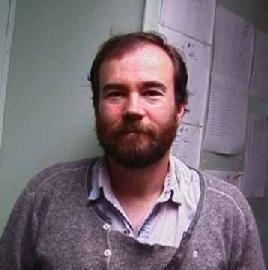 I have been working
as a mechanical tech with the ROPOS ROV
for almost three years. Like all the ROPOS crew, I have specialized training,
but in practice am a generalist. In the course of a cruise I may be maintaining
the vehicle, repairing cabling, providing acoustic
navigation, making new brackets for installing equipment, assisting
with the manipulators or doing a little relief piloting. My path to the
world of scientific research by ROV has many bends. The bends in lifes
road are what make it interesting to me. I started out as a biological
oceanographic technician and then branched out into supporting physical,
chemical and geological oceanographic research as well. As well as assisting
in data collection, I began to modify and design pieces of oceanographic
equipment. It seemed there was never enough of one thing, but that didnt
matter because I liked the variety. There was always someone asking
I have been working
as a mechanical tech with the ROPOS ROV
for almost three years. Like all the ROPOS crew, I have specialized training,
but in practice am a generalist. In the course of a cruise I may be maintaining
the vehicle, repairing cabling, providing acoustic
navigation, making new brackets for installing equipment, assisting
with the manipulators or doing a little relief piloting. My path to the
world of scientific research by ROV has many bends. The bends in lifes
road are what make it interesting to me. I started out as a biological
oceanographic technician and then branched out into supporting physical,
chemical and geological oceanographic research as well. As well as assisting
in data collection, I began to modify and design pieces of oceanographic
equipment. It seemed there was never enough of one thing, but that didnt
matter because I liked the variety. There was always someone asking
"Do you think you could do this?"
"I don't know. I've never done it before. Why not?," I answered perhaps a
few times more than was healthy.
Everyday working with the ROPOS there is something new. The scientists involved are always investigating and exploring new ideas, and there is a feeling of discovery on every cruise. At hydrothermal vents, even though research has been conductive for 20 years, something new is encountered on every cruise. Perhaps it is a new species of animal, hot water where it is not expected or the fresh lava flow of a volcano 1500 metres below the surface. I was trained to sample from a ship using nets and bottles lowered blindly thousands of metres below the surface and to tow instrumentation on a wire through the water column. The ocean seemed very large when we only captured small glimpses of it in bottles and or on narrow transects. There is something very attractive to being able to see and sample the water, fauna or ocean floor selectively. One of my favourite ways on shore of observing sea life is to sit on the rocks at the beach near my home, and watch Sharp Nose Crabs crawling in amongst the seaweed and barnacles. I watched their interaction and feeding for many hours. I get the same feeling with ROPOS while watching the monitor as a Vent crab crawls through fields of tubeworms.
It is also the variety of research and technologies involved that make working ROPOS interesting to me. The vehicle is set up as a versatile work platform that allows the researcher to add an unlimited range of sensors and samplers. A broadcast quality 3-chip colour camera allows the researcher the ability to make detailed video surveys of a deep ocean world far removed from the light of day. The two manipulators make a powerful team to deploy equipment and selectively sample on the bottom. The Scientific Telemetry System (STS) and science junction box allow the researcher to bring their sensors and plug them in. The system is rapidly configurable and can accommodate up to 8 serial instruments using RS232 or 422 at 9600 baud with a power supply of 12 or 24V and all that is needed is to bring a suitable 3 or 4 pin underwater connector with the package. With a change of ballast weight ROPOS can accommodate many sensors or samplers on a dive. For one set of dives last year we had over 300 pounds of scientific payload including an Imagenex sonar mapping system, a digital still camera with twin strobes, the SUAVE analyser, a biological sample box, two gas tight sampling bottles and two Niskin samplers.
Above all it is working with the ROPOS crew that is most enjoyable. There is constant innovation and creativity that goes into every dive. Sometimes a piece of equipment is broken and needs to be repaired when there are not the right materials. Quite often, the conditions encountered are different than expected and we must develop new tools or techniques for the job. We make use of whatever is at hand and make it work. Everyone has particular skills to contribute and the combination of varied experience is very effective. Working in this environment is always exciting and makes the unexpected a more enjoyable experience.
July 2
Mike Perfit and John Chadwick
University of Florida
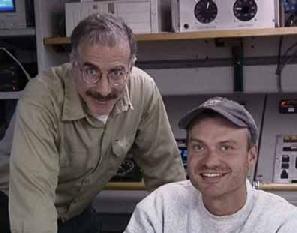 We make
up the "hardrock" contingent of the expedition. We are investigating magma
genesis along the Juan de Fuca Ridge and the chemistry of lavas that make
up Axial Volcano and its adjacent rift zones. We like to remind everyone
on board that if it wasn't for the eruption of magma on to the seafloor
there wouldnt be any hydrothermal activity, mineral deposits or bugs for
them to study. So really we are the most important group of scientists
out here!!! That probably explains why they make us stay up all night
taking samples of basalt with our wax
corer when ROPOS isn't diving.
We make
up the "hardrock" contingent of the expedition. We are investigating magma
genesis along the Juan de Fuca Ridge and the chemistry of lavas that make
up Axial Volcano and its adjacent rift zones. We like to remind everyone
on board that if it wasn't for the eruption of magma on to the seafloor
there wouldnt be any hydrothermal activity, mineral deposits or bugs for
them to study. So really we are the most important group of scientists
out here!!! That probably explains why they make us stay up all night
taking samples of basalt with our wax
corer when ROPOS isn't diving.
Actually, we do rely on ROPOS to recover large, well located basalt samples from the newly erupted lava as well as the older lavas that surround the new flow. We are very interested in the chemical and mineralogic components in the lava flow. Chemical analyses of the recovered samples completed back in our geochemistry labs at the University of Florida and at the US Geological Survey in Denver will tell us what the source of the magma is and if there has been a recent change in the temperature and chemical evolution of the magma chamber that underlies Axial's caldera. Because there are so many biologic and hydrochemical experiments going on during ROPOS dives, we often have to "settle" for bits of basalt that are sucked up with bacterial mats, snails and scale worms or picked up with attached tubeworms. The biologists are kind enough to give us the "slimed" samples after they have extracted their prey.
When ROPOS is not diving we use a 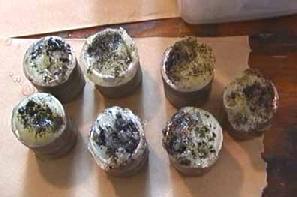 400 lb. coring device (built by we have had excellent success
( 97 % recovery rate) while sampling 35 different sites along the rift
zone that extends south of Axial. We have not yet approached the record
recovery that John had last year when the core wire wrapped around a pillow
lava and brought over 100 lbs of rock up with the corer!!. To
insure recovery this year, we had an observer travel down nearly 2000m
with the core. Honey Bear volunteered to personally oversee the coring
operation. Under great pressure, he succeeded in sampling some very difficult
parts of the seafloor.
400 lb. coring device (built by we have had excellent success
( 97 % recovery rate) while sampling 35 different sites along the rift
zone that extends south of Axial. We have not yet approached the record
recovery that John had last year when the core wire wrapped around a pillow
lava and brought over 100 lbs of rock up with the corer!!. To
insure recovery this year, we had an observer travel down nearly 2000m
with the core. Honey Bear volunteered to personally oversee the coring
operation. Under great pressure, he succeeded in sampling some very difficult
parts of the seafloor.
Mike Perfit
I am a Professor at the University of Florida (home of the "fighting Gators") and specialize in Igneous Petrology (the study of rocks that form from magma) and Marine Geology. My first cruise was to the Caribbean Sea when I was a graduate student and at that time, I was so seasick that I vowed I would never go again. But here I am again, nearly 25 years and 17 cruises later, enjoying the science, adventure and camaraderie of being at sea. I look forward to working with many scientists and students with diverse backgrounds and interests and the discoveries that come from our multidisciplinary method of studying the seafloor. I have participated on many cruises using the manned submersible ALVIN, but this is the first time I have had the opportunity to use ROPOS. Even though we work very long and sometimes erratic hours, I find it relaxing to be away from the daily confusion in my office and satisfying to be focused on one objective . I can also avoid cooking, cleaning and mowing the lawn! However, it is difficult to be away from my family for a month at a time (at least we have e-mail).
I have known Chief Scientist Bob since we were graduate students at Lamont-Doherty Geological Observatory. We have been on quite a few cruises together and I have enjoyed investigating the Galapagos Spreading Center and many portions of the Juan de Fuca Ridge with him. Bill Chadwick and I have also worked on a number of projects related to the volcanology of mid-ocean ridges. I use much of what I learn out here in my classroom lectures and impressing my friends at dinner parties. The National Science Foundation has funded my research on the Juan de Fuca Ridge and has provided financial support for my graduate students (including John). Doing research like this has been a life-long dream of mine and I am very glad to be out here on this exciting cruise.
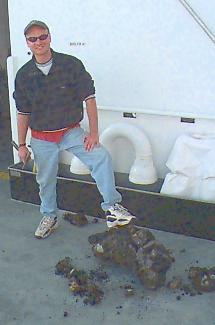 Hello. Im John Chadwick, a Ph.D. student from the
University of
Florida studying the volcanic and tectonic (faults) history of
Axial
Volcano and the neighboring
Juan de Fuca mid-ocean ridge. I'm interested
in how the chemistry of Axial's lavas have changed over time, and how the
volcano interacts with the mid-ocean ridge.To a geologist like myself,
the little animals and bacteria that are a main focus of this expedition
into the Pacific fall into three categories:
Hello. Im John Chadwick, a Ph.D. student from the
University of
Florida studying the volcanic and tectonic (faults) history of
Axial
Volcano and the neighboring
Juan de Fuca mid-ocean ridge. I'm interested
in how the chemistry of Axial's lavas have changed over time, and how the
volcano interacts with the mid-ocean ridge.To a geologist like myself,
the little animals and bacteria that are a main focus of this expedition
into the Pacific fall into three categories:
Its the rocks under the sticky stuff that we love to talk about. But I realized the other day that the collection of geologists, biologists, and chemists on the ship allows for a unique opportunity to interact and learn from each other. After we retrieved a large sample of basalt rock from the ocean floor on Wednesday using ROPOS (that we will use for geochemical analysis), Mike noticed that there were little worms crawling around under an upper layer of rock. The biology people came to collect these narids and bamboo worms (day- and week-old macaroni and cheese, respectively), and a discussion of what the worms might be doing there ensued. The geologists knew rock stuff, and the biologists knew worm stuff, and a better understanding of that ecosystem was reached than could have been if either group was working alone. This type of interaction happens a lot. And why not? Everything is linked out here: the hot magma that is the engine for volcanic eruptions and earthquakes also heats up the water in the rock and creates the hydrothermal vents, which in turn support the fragile and tenuous ecosystems containing the exotic life forms. Were all learning from each other out here; not just deepening our scientific understanding of our own specialties, but broadening our understanding of Axial Volcano as a whole.
July 1
Kim Juniper
University of Quebec
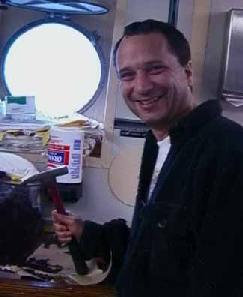 Sometimes scientists get
into a particular field of research through reading and natural curiosity.
More often than not, chance comes into play. Sixteen years ago this summer
I was invited at the last minute to join an oceanographic cruise to the
Juan
de Fuca Ridge. It turned out to be the discovery cruise that found
the first hydrothermal vents in the northeast Pacific Ocean, here
on Axial Volcano. I remember exactly where I was standing on the ship
when the divers in the Pisces IV submersible called up from below to announce
that they had found hot water vents. After the exhilaration of the cruise,
I went to see Ralph Brinkhurst, my post-doctoral supervisor at the Institute
of Ocean Sciences in Sidney, British Columbia. I had worked myself
up to informing him that I wished to terminate the project that he had
assigned me so that I could throw myself into hydrothermal vent research.
Rather than reining me in to carry on with the fjord project that I had
begun six months before, Ralph told me to go for it.
Sometimes scientists get
into a particular field of research through reading and natural curiosity.
More often than not, chance comes into play. Sixteen years ago this summer
I was invited at the last minute to join an oceanographic cruise to the
Juan
de Fuca Ridge. It turned out to be the discovery cruise that found
the first hydrothermal vents in the northeast Pacific Ocean, here
on Axial Volcano. I remember exactly where I was standing on the ship
when the divers in the Pisces IV submersible called up from below to announce
that they had found hot water vents. After the exhilaration of the cruise,
I went to see Ralph Brinkhurst, my post-doctoral supervisor at the Institute
of Ocean Sciences in Sidney, British Columbia. I had worked myself
up to informing him that I wished to terminate the project that he had
assigned me so that I could throw myself into hydrothermal vent research.
Rather than reining me in to carry on with the fjord project that I had
begun six months before, Ralph told me to go for it.
Lately work in my lab has been focusing on the role of free-living microbes as food sources for vent animals. Much is said about how vent ecosystems are unique on the planet because microbes rather than plants provide the basic food energy. Yet we still know very little about how these ecosystems are organized; particularly the "who eats who" part. During the NeMO cruise my students and I are studying vent webs on Axial Volcano. Catherine Charpentier, a student from France, is using a couple of chemical techniques to measure the biomass of microbes in all the samples of floating particles and biofilms that the ROPOS collects. That will provide us with some real data on how much food is actual available. Christian Levesque, a PhD student, is looking at stable isotopes of carbon and nitrogen, and fatty acid biomarkers in animal tissues and comparing them to different food sources. Making these comparisons in vent communities at different stages of development will enable him to understand how vent food webs change as the ecosystem becomes more complex. Marlene Le Bel, a biology undergraduate, is using recorded video images to map the distribution of different types of vent communities within vent fields and on mineral chimneys. Comparing maps from one year to the next will allow us to understand how dynamic these communities really are and how they change in relation to environmental conditions. Finally, ROPOS video cameras are also being used to record how different worm species gather their food, and even defend their feeding territories. Yes, that's right - worms beating up on worms at 1500 metres below the surface of the ocean. There's a lesson in there for all of us. Even when there is abundance, some creatures just can't get enough.
June 30
Craig Moyer and
Karen Lynch
Western Washington University
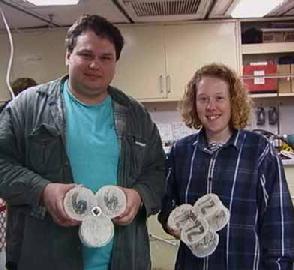 Hello and welcome to NeMO99! My name is Craig Moyer.
I am an assistant professor at Western Washington University, where I
am a member of the biology department. My specialty is molecular microbial
ecology of hydrothermal vent habitats. You may wonder what exactly
is it that a molecular microbial ecologist does (I know I do . . . often).
Well, because most prokaryotes (Bacteria and Archaea) look alike, I use
bio-molecules like ribosomal DNA as name tags to help identify the different
kinds of microbes that like to live at hydrothermal vents like the
ones here at Axial Volcano. These bio-molecules not only work just like
the bar codes that get scanned at the grocery store, but they also store
information regarding who is most related to whom. Therefore, my job
is basically that of a microbe census-taker and genealogist. In addition,
I try to understand he ecology the hydrothermal system by examining how
the structure of the microbial community relates to the different types
of chemistry we see at the vents. If that weren't enough, I also attempt
to keep track of how these microbial communities change across space (across
a single vent, from one end of the vent site to the other, or even from
one geographical region to another) and over time (from days to months
to years).
Hello and welcome to NeMO99! My name is Craig Moyer.
I am an assistant professor at Western Washington University, where I
am a member of the biology department. My specialty is molecular microbial
ecology of hydrothermal vent habitats. You may wonder what exactly
is it that a molecular microbial ecologist does (I know I do . . . often).
Well, because most prokaryotes (Bacteria and Archaea) look alike, I use
bio-molecules like ribosomal DNA as name tags to help identify the different
kinds of microbes that like to live at hydrothermal vents like the
ones here at Axial Volcano. These bio-molecules not only work just like
the bar codes that get scanned at the grocery store, but they also store
information regarding who is most related to whom. Therefore, my job
is basically that of a microbe census-taker and genealogist. In addition,
I try to understand he ecology the hydrothermal system by examining how
the structure of the microbial community relates to the different types
of chemistry we see at the vents. If that weren't enough, I also attempt
to keep track of how these microbial communities change across space (across
a single vent, from one end of the vent site to the other, or even from
one geographical region to another) and over time (from days to months
to years).
Hydrothermal vents are a great place to study the structure and diversity of microbes because many scientists now think that these habitats are where life began almost 4 billion years ago. This means that studying vent microbes is like looking at organisms that have been around for a long time and therefore have been very successful; like studying the Coelacanth if you are interested in fish. Since hydrothermal vents are considered extreme environments, this tends to keep the overall numbers of different types of microbes lower in any single habitat or location than what you would find someplace more mild like forest soil, which has on the order of 10,000 to 100,000 different kinds of microbes per gram! This makes my job a little easier.
In order to sample the microbial communities, myself and my grad student Karen
Lynch employ a couple of different approaches. First, we use an 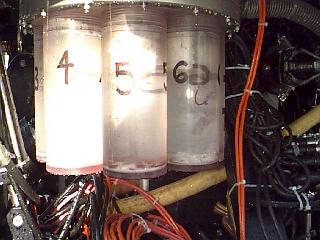 underwater device attached to ROPOS called the slurp-gun to vacuum up
microbial mats and capture them in sample jars (photo left, NeMO 1998).
Second, we use bacteria traps
which we leave in place for a set amount of time, allowing the colonization
of microbes as the vent effluent passes through a cylinder covered with
a fine mesh with glass wool inside. The bacteria are what we call substrate-limited,
so we give them a place (in this case glass wool made of inert silica
as a substrate) to attach as the hot vent water passes through. The mesh
is to keep the bigger animals like tube worms, palm worms and scale worms
from eating up all of our samples. Basically, we provide the microbes
with a refuge and happy place for them to grow. Upon recovery of these
samples, we then preserve them for later molecular biological analysis.
underwater device attached to ROPOS called the slurp-gun to vacuum up
microbial mats and capture them in sample jars (photo left, NeMO 1998).
Second, we use bacteria traps
which we leave in place for a set amount of time, allowing the colonization
of microbes as the vent effluent passes through a cylinder covered with
a fine mesh with glass wool inside. The bacteria are what we call substrate-limited,
so we give them a place (in this case glass wool made of inert silica
as a substrate) to attach as the hot vent water passes through. The mesh
is to keep the bigger animals like tube worms, palm worms and scale worms
from eating up all of our samples. Basically, we provide the microbes
with a refuge and happy place for them to grow. Upon recovery of these
samples, we then preserve them for later molecular biological analysis.
In addition to studying microbial communities, I am also interested in culturing as we microbiologists call it, the more significant members from within the community. This means trying to get the individual types of microbes which are the major players to grow in the laboratory. This isn't always an easy task, as many if not most microbes have been found to be unculturable. That doesn't stop us from trying new ways to make them happy. Together with my colleague David Emerson at the American Type Culture Collection, we discovered a novel way to culture a new kind of iron-oxidizing bacteria that is able to live completely off the energy from the oxidation of iron (similar to the formation of rust) without requiring a lot of acid around to do it. We have found that this type of bacteria is a major component in many hydrothermal vent systems, and hope to find it here at Axial Volcano as well.
I've been studying the diversity and structure of microbial communities for nearly 9 years now with much of my work happening at places like Loihi, an undersea volcano in Hawaii, or the Guaymas Basin in Mexico. I have been a part of many dive programs with over 90 dives using submersibles and tethered-vehicles, and during this time I have not seen such an amazingly productive tool as ROPOS. It is truly an undersea platform for the future. As I'm sure you an tell from looking at the series of homepages from the NeMO 99 expedition to Axial Volcano, there are many scientists out here with many different projects and interests, and ROPOS has come through like a champ allowing us all to have a wonderful window into the hydrothermal world below. Kudos to the ROPOS team for keeping us in the water!
Karen Lynch
My name is Karen Lynch and I am a graduate student in Biology at Western Washington University. My thesis project includes examining the microbial community structure and diversity found at Axial Seamount, and then to determine the phylogeny (where the different types of microbes are located on the Tree of Life) of these unusual bugs. This is accomplished with the extraction of DNA from microbial samples, and then examination of PCR copied DNA fragments using molecular techniques such as ARDRA or amplified ribosomal DNA restriction analysis. This approach allows me to estimate the abundance of different microbial populations within a sampled community.I have begun my research with samples collected from last year's NeMO 98 cruise. On this year's cruise, I am collecting a new set of samples from the same sites as last year with the hope of comparing the community structure and diversity on a temporal basis. Once these new samples are brought back to the ship, I then, with the help of my advisor, Craig Moyer, fast freeze the samples with liquid nitrogen and dry ice once they have been concentrated. In addition, we process subsamples with fixatives and cryopreservants for microscopic analysis and culturing. I also participate in a watch from midnight to 4am whenever the sub is in the water, where I am responsible for logging all the samples collected and taking frame-grabs off the video feed. Since this is my first research cruise, I wasn't quite sure what to expect. However, it's been an enjoyable eye-opening experience (once I got my sea legs), one in which I wish to repeat if the opportunity arises.
June 29
Morgan Turrell
Chief Officer,
Thomas G. Thompson
 As another crew member
aboard the Thompson, I am lucky to be a shipmate
with some great people. Without some of these quality individuals,
my job would be more difficult. Safety is my primary objective.
As another crew member
aboard the Thompson, I am lucky to be a shipmate
with some great people. Without some of these quality individuals,
my job would be more difficult. Safety is my primary objective.
I used to work on commercial cargo ships. For a year now, Ive been on the Thompson. The change has been rewarding. Each trip is different so there are new challenges and I enjoy watching science in action. Working with so many scientists from unique backgrounds makes each trip memorable. As a sailor I have learned so much about the environment from our work out here. With ROVs and new high-tech instruments, I am watching technology uncover an ocean I took for granted.
People and technology are inseparable out here. One couldn't exist without the other. Without the marvelous satellite and digital technology, our crew couldnt get the ship and scientists to precise locations, yet without the scientific curiosity, the technology would be useless. I learn something new everyday.
On the Thompson, everyone is both a student and a teacher. Captain Games, our crew and the scientists have made learning fun and I thank them.
June 28
Dave Butterfield
NOAA Vents Program/University of Washington
 Hello, my name is Dave Butterfield,
I'm an oceanographer with the University
of Washington, and I work with the NOAA
VENTS Program in Seattle. I've been studying submarine volcanoes and
hydrothermal fluid chemistry since my graduate student days beginning in
1984. My research in the last few years has focused on how the submarine
hot springs change over time after volcanic activity on the seafloor, and
also on the connection between the microbial communities that live below
the seafloor and the composition of the fluids. That link between chemistry
and biology is a big part of our work out here this year for NEMO.
Hello, my name is Dave Butterfield,
I'm an oceanographer with the University
of Washington, and I work with the NOAA
VENTS Program in Seattle. I've been studying submarine volcanoes and
hydrothermal fluid chemistry since my graduate student days beginning in
1984. My research in the last few years has focused on how the submarine
hot springs change over time after volcanic activity on the seafloor, and
also on the connection between the microbial communities that live below
the seafloor and the composition of the fluids. That link between chemistry
and biology is a big part of our work out here this year for NEMO.
Our early dives on ROPOS this year have yielded some great samples for our chemistry-microbiology work (in collaboration with colleagues from the University of Washington, Western Washington University, and the University of Montreal). Some of the vents that we sampled last year have nearly died out, but others have heated up, and more vent animals have colonized some of the sites. One of the most spectacular finds occurred at the end of a 20-hour dive yesterday. We were investigating a line of vents that last year all had a similar appearance of whitish vent fluid, hence the names: Milky, Ouzo, and Magnesia. The first two sites along this line of vents were nearly dead and covered with orange, iron-rich mats. The next site showed faint signs of venting, and then we found a very active "snowblower" vent that was venting clouds of whitish fluid with flocs of white material in it. As we sat in front of this vent, taking as many fluid and particle samples as we could, one person after another in the noisy, crowded control room was heard to say, "hey, that looks just like one of those liquid-filled toy scenes with plastic snow that you shake up. "Snowblower"-type vents have been found at several sites after volcanic eruptions (click for video of a snowblower site at CoAxial seismic site), and the processes producing them are still being debated. We're hoping to learn something from our samples.
I feel lucky to be able to do oceanographic research as a career. The science is a lot of fun, as new questions are always coming up, and it challenges one's energy and creativity to come up with answers. I think people who stay scientists fall in love with this process of solving little mysteries, or, ever so seldom, a big one.
The scientific aspect of oceanography is not unlike any other discipline: we gather and analyze data to develop and test hypotheses about how things work. But, the culture of going to sea sets oceanographers apart. Most of us live with fairly predictable daily and weekly routines on land (working hours, weekends, household maintenance). There's an even tighter clockwork for how ships are run (many of the crew work specified four-hour watches twice a day, and there are set meal times). But when you get on a research ship to do the kind of scientific research we are doing out on this NEMO cruise, you say goodbye to your life on land and throw away all routine. It's an intense experience, to be in a confined space out on the ocean, focused on a project and the tasks that need to be completed. Living and working with your colleagues for a month, nonstop, you get to know people in a way that just doesn't happen in an office environment. This experience stays with you. I'm glad to have had it.
And going home is always sweet.
June 27
Bill Chadwick
NOAA Vents Program/Oregon State University
 My name is Bill Chadwick.
For the past decade, I've been studying submarine volcanic eruptions on
the Juan
de Fuca and Gorda Ridges with the NOAA/Vents
Program, through Oregon State University.
I'm a volcanologist - someone who studies active volcanoes. The last 10
years has been a great time to study deep ocean eruptions because we have
only had the
technology to detect such eruptions within that short time. Before
that, we had no way of knowing when an eruption might be occuring on the
mid-ocean ridge system, even though 75% of the Earth's volcanism occurs
there, but now submarine eruptions can be detected routinely in the NE
Pacific. This has been a very exciting development and has allowed us
to learn a lot about them in a short period of time.
My name is Bill Chadwick.
For the past decade, I've been studying submarine volcanic eruptions on
the Juan
de Fuca and Gorda Ridges with the NOAA/Vents
Program, through Oregon State University.
I'm a volcanologist - someone who studies active volcanoes. The last 10
years has been a great time to study deep ocean eruptions because we have
only had the
technology to detect such eruptions within that short time. Before
that, we had no way of knowing when an eruption might be occuring on the
mid-ocean ridge system, even though 75% of the Earth's volcanism occurs
there, but now submarine eruptions can be detected routinely in the NE
Pacific. This has been a very exciting development and has allowed us
to learn a lot about them in a short period of time.
So obviously one of my primary interests here at Axial Volcano is learning about the character of the 1998 eruption, the lava flow it produced, and about the behavior of Axial volcano in general. For example, some of the questions I'm trying to answer include: how much lava came out? over what area? how fast did it come out? how do the lava morphologies we see give clues to how the eruption evolved through time? how is this eruption similar or different from other submarine eruptions we've studied? For a lot of these questions we have partial answers from our NeMO research cruise last year, and we hope to find more answers this summer.
Our primary tool is the video of ROPOS - going down to the bottom and looking
around. We make geologic
transects so that we can map out the location and extent of the new lava.
Navigation of ROPOS on the bottom is critical to this sort of effort -
you have to know where you are at all times to make any sense out of your
observations - so ROPOS navigation
is one of the areas I oversee. We also use the scanning
sonar on ROPOS to collect high-resolution
bathymetry of the eruption site. This bathymetry allows us to make
maps that show details of the eruption site over a much larger area than
you can view with ROPOS's video camera. Such maps show us many features
of the eruption site that would be hard to discern otherwise, and we plan
to collect more of this data this year. I'm also working with some innovative
seafloor instruments called 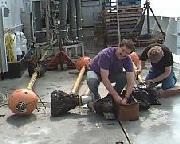 acoustic
extensometers that are designed to measure distances very precisely
between points on the ocean floor. These distance measurements can detect
deformation of the volcano caused by movements of magma underground and
is one of the standard methods used to monitor active volcanoes on land.
Some of our extensometers (photo left) were in place on Axial's north
rift zone when the 1998 occurred, and we recovered them last year. It
turns out they measured a distance change of 4 centimeters at the time
of the eruption, from which we can estimate the depth to the magma
reservoir beneath Axial's summit caldera and calculate how much magma
was removed from it during the eruption. We redeployed the instruments
on the north rift zone last summer where they have been recording data
since then, and we plan to recover and redeploy them again this year.
acoustic
extensometers that are designed to measure distances very precisely
between points on the ocean floor. These distance measurements can detect
deformation of the volcano caused by movements of magma underground and
is one of the standard methods used to monitor active volcanoes on land.
Some of our extensometers (photo left) were in place on Axial's north
rift zone when the 1998 occurred, and we recovered them last year. It
turns out they measured a distance change of 4 centimeters at the time
of the eruption, from which we can estimate the depth to the magma
reservoir beneath Axial's summit caldera and calculate how much magma
was removed from it during the eruption. We redeployed the instruments
on the north rift zone last summer where they have been recording data
since then, and we plan to recover and redeploy them again this year.
Trying to study volcanoes on the bottom of the ocean is challenging work - you can't just walk around on them or drive on them or look out your window to see what's going on like you can at volcanoes on land. But on the other hand, since they are harder to observe and we know so much less about them, it makes every discovery seem significant and new. That's a feeling scientist like to have. It makes it fun.
Finally, I'd like to say hi to my wife Teresa and my daughter Kelly, who are helping each other manage while dad is away from home at sea. Kelly is 6 years old and is currently fascinated with the meaning of the word "infinity". She has been telling me lately "I love you, daddy, infinity!" Well, I would like to tell them both that I miss them, infinity!!
June 26
Thomas Chapin
Monterey Bay Aquarium Research Institure (MBARI)
 Hi. I'm Thomas
Chapin, a scientist from the Monterey Bay Aquarium Research Institute
(MBARI, www.mbari.org). I work at
MBARI with Hans Jannasch, Geoff Wheat,
and Ken Johnson developing long term underwater samplers (Osmo
Samplers) and chemical analyzers (Osmo Analyzers) for monitoring hydrothermal
vents. Scientists have been able to get out to the Juan de Fuca ridge
fairly often and have begun to develop some theories on the chemical evolution
of hydrothermal systems from eruption to when the vents die out. However,
the chemical sampling has mostly been accomplished with ships and ROVs
which, if you're lucky, get out here once or twice a year for a few weeks.
That's like only seeing 10 minutes of a 2 hour movie; you get some
idea of the plot but you're making educated guesses about what happened
before you got there or what happens after you leave. That's where the
MBARI folks come in, we put down Osmo Samplers and Osmo Analyzers that
continuously collect samples and data for up to a year.
Hi. I'm Thomas
Chapin, a scientist from the Monterey Bay Aquarium Research Institute
(MBARI, www.mbari.org). I work at
MBARI with Hans Jannasch, Geoff Wheat,
and Ken Johnson developing long term underwater samplers (Osmo
Samplers) and chemical analyzers (Osmo Analyzers) for monitoring hydrothermal
vents. Scientists have been able to get out to the Juan de Fuca ridge
fairly often and have begun to develop some theories on the chemical evolution
of hydrothermal systems from eruption to when the vents die out. However,
the chemical sampling has mostly been accomplished with ships and ROVs
which, if you're lucky, get out here once or twice a year for a few weeks.
That's like only seeing 10 minutes of a 2 hour movie; you get some
idea of the plot but you're making educated guesses about what happened
before you got there or what happens after you leave. That's where the
MBARI folks come in, we put down Osmo Samplers and Osmo Analyzers that
continuously collect samples and data for up to a year.
There are many potential problems with long term continuous samplers and analyzers including limited power, fouling of intakes, moving parts wearing out, etc. To overcome some of these major problems, we use osmotic pumps. These are pumps, which rely on osmosis, the principle that water will cross a semi-permeable membrane to try and balance outs the salt concentration on both sides. Since you have water moving from one side of the membrane to the other, you are effectively pumping it, and we can employ this idea to move samples and reagents. The coolest thing about the osmotic pump is that it requires no electrical power to move water! It also moves water very slowly, about 0.25 ml/day. Osmo Samplers continuously pull the hydrothermal water into a really long (>200m) coil of tubing. After a year, we pick up the Osmo Sampler and cut the tubing up, each meter of tubing is about 2 days worth of sample. So the Osmo Sampler requires no electricity and just sucks sample into a long coil of tubing. On the other hand, the Osmo Analyzer is an instrument, which does require some battery power to continuously measure iron (Fe) concentrations in hydrothermal vents. Osmotic pumps are used to add reagents to the sample to make a colored compound. The color intensity, which is proportional to the Fe concentration, is then measured every 30 minutes. A data logger and battery pack provides the program and power to run the electronics. I'll be recovering two Osmo Samplers, which were deployed last year and bring them back to lab for analysis. This data will be incredible since we'll be able to see changes in hydrothermal chemistry over the entire year with almost a daily resolution. For this cruise, I will be deploying four Osmo Samplers and two Fe Osmo Analyzers, which will be picked up next year.
June 25
Jim Gendron
NOAA Vents Program
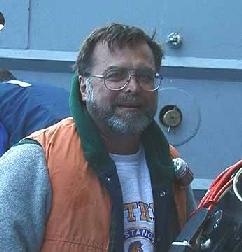 My name is Jim Gendron.
I am an oceanographer with NOAA's Pacific
Marine Environmental Laboratory in Seattle. I have been with the lab
for 19 years. My main interest in the VENTS program is to help further
the understanding of hydrothermal particulate matter. This includes trying
to determine how they form, and their distribution and chemical makeup
and evolution. I also have a strong interest in radon, a radioactive gas
that is found in very high levels in the vents.
My name is Jim Gendron.
I am an oceanographer with NOAA's Pacific
Marine Environmental Laboratory in Seattle. I have been with the lab
for 19 years. My main interest in the VENTS program is to help further
the understanding of hydrothermal particulate matter. This includes trying
to determine how they form, and their distribution and chemical makeup
and evolution. I also have a strong interest in radon, a radioactive gas
that is found in very high levels in the vents.
This work at Axial volcano is very exciting. I participated in the response cruise in February 1998, which was right after the original eruption. The samples that were collected then showed that very large particles had been blown high into the water column. When we visited Axial volcano last summer, the plumes over the volcano were reduced in volume and the average particle size was smaller. ROPOS did find lots of interesting activity on the bottom. So far this year the vent sites that we have visited seem to be more focused and at least one vent, somewhat warmer.
The main tools that we use to collect particulate matter with ROPOS are the fluid sampler that Dave Butterfield has developed and conventional Niskin samplers. The Niskins are PVC tubes that can collect about 5 liters of sample at once. The Niskins are then pressurized with nitrogen and the sample is pushed through a polycarbonate filter. We try to collect up to 500 micrograms per filter. The filters are then dried and when we return to the lab they are analyzed for 17 elements by X-ray fluorescence (XRF).
In general, eruptions such as the one at Axial volcano in 1998, release a very large amount of metals, especially iron, into the surrounding sea water. In addition, they remove a large amount of dissolved phosphate, which in the surface waters, is an important nutrient.
June 24
Kevin Roe
NOAA Vents Program
 My name is Kevin Roe
and I work out of NOAA/PMEL in Seattle. I'm on my fifth research cruise
since last June, all of which are either manned or unmanned submersible
cruises. I went on my first research cruise 21 years ago. This was only
one year after the first hydrothermal vents were discovered and I am only
in mid-career. I came to NOAA/PMEL in late 1984 with the expressed interest
to help in the study of the chemistry
of hydrothermal vent fluids and hydrothermal plume chemistry. Dreams
do come true!
My name is Kevin Roe
and I work out of NOAA/PMEL in Seattle. I'm on my fifth research cruise
since last June, all of which are either manned or unmanned submersible
cruises. I went on my first research cruise 21 years ago. This was only
one year after the first hydrothermal vents were discovered and I am only
in mid-career. I came to NOAA/PMEL in late 1984 with the expressed interest
to help in the study of the chemistry
of hydrothermal vent fluids and hydrothermal plume chemistry. Dreams
do come true!
Hydrothermal vent fluids can range in temperature from slightly above
bottom seawater temperature (>2o C-60oC) also called diffuse venting,
to high temperature vent fluids with a maximum temperature slightly
above 400o C. My job on board is to first analyze vent fluids for
dissolved chemicals that are best analyzed immediately, such as ammonia,
hydrogen sulfide, silica and measure pH quickly before oxidation,
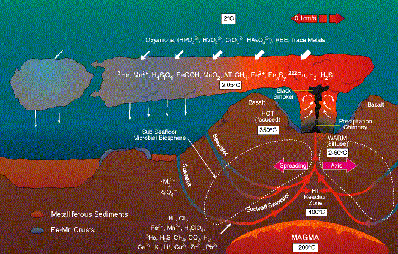
(click for full size)
precipitation, bacterial utilization or simple degassing occur. Secondly,
I take samples that can be preserved for analyzes back at the lab. I then
analyze dissolve metals such as iron, manganese, zinc, copper, cadmium,
silver, and lead and major ions such as sodium, chloride, magnesium,
sulfate, calcium, strontium, potassium, borate, and trace elements. I
have to use a variety of techniques and I'm doing some of my data
reduction from laboratory analyzes in my spare time aboard the ship.
What is done with all this data? Microbiologists and biologists need to know the sulfide concentrations as sulfide is one of the "fuels" of the vent community ecosystem. Sulfide, pH, iron and major ions change with time when a volcanic event occurs and analysis of these components over time give a clue to the evolution of the heat source and the future of the local biological community. If the hydrothermal fluid encounters sediment before venting, high concentrations of ammonia and boron are measured in the vent fluids. If vent fluids are less "salty" than seawater, phase separation (boiling) has occurred and this gives a clue to the depth and temperature of the heat source.
To date, it has been a little slow as the fluid sampler has not been put to use. Once we begin to get vent fluids, I'll be very busy, sometimes working for 24 hours straight as do many of us on board. When you helping to solve a mystery, you lose track of time.
June 23
Julie Huber
Graduate Student University of Washington
 Well, I've been living
on this ship for almost a week now and have little to show for it except
a dramatic improvement in my ping-pong game and a bizarre sleeping schedule
that keeps me awake through my midnight to 4 am watch. But that's really
not why I came out here. As a second year graduate student with John
Baross at the University of Washington, I returned to sea this summer
to continue my research on microbial communities in diffuse fluids on
Axial Seamount.
Hydrothermal systems support an amazing variety of extremely talented
microbes- microbes that can thrive at
high pressures, high concentrations of salt and toxic metals, and of course,
since they are found in hot vent environments, high temperatures. I am
particularly interested in the types of microorganisms living in diffuse
flow, which is a mixture of hot hydrothermal fluid and cold seawater circulating
through the ocean crust. Axial Seamount is an excellent place to study
microbes in diffuse fluids due to the volcanic events occurring here which
potentially bring microorganisms and fluids from the subsurface biosphere
to the seafloor where they can be sampled. So along with Dave
Butterfield, a chemist at NOAA/PMEL,
I am trying to quantify the diversity of microbes and their metabolisms
in relation to the chemistry of the diffuse fluids. I spend a lot of time
exploring new vent sites and trying to culture interesting bugs that grow
at high temperature under different nutritional conditions. We also use
a variety of molecular tools to take a closer look at the microbial community
structure and distribution of certain individuals in the diffuse fluids.
Not only does this research allow us to better understand the interactions
between microbes and hydrothermal fluids, it also lets us peer into the
subsurface seafloor environment and determine how these subsurface biotopes
may be related to one another, if at all. Last year at Axial we did extensive
sampling of many diffuse sites all around the volcano. The specific goal
of this year's expedition is to focus our sampling efforts on a few interesting
sites in order to determine how any changes in the fluid chemistry over
the past year may be reflected in the microbial community structure. Most
of my samples will be collected with the Vent
Fluid Sampler, a gem of a collection device for microbiologists and
chemists alike. For now, though, ROPOS is diving with the Biobox
to collect tubeworms and traps and other macro-objects. Meanwhile, I'm
watching porpoises play in the bow and
working on my backspin as I wait for the subsurface exploring to begin.
Well, I've been living
on this ship for almost a week now and have little to show for it except
a dramatic improvement in my ping-pong game and a bizarre sleeping schedule
that keeps me awake through my midnight to 4 am watch. But that's really
not why I came out here. As a second year graduate student with John
Baross at the University of Washington, I returned to sea this summer
to continue my research on microbial communities in diffuse fluids on
Axial Seamount.
Hydrothermal systems support an amazing variety of extremely talented
microbes- microbes that can thrive at
high pressures, high concentrations of salt and toxic metals, and of course,
since they are found in hot vent environments, high temperatures. I am
particularly interested in the types of microorganisms living in diffuse
flow, which is a mixture of hot hydrothermal fluid and cold seawater circulating
through the ocean crust. Axial Seamount is an excellent place to study
microbes in diffuse fluids due to the volcanic events occurring here which
potentially bring microorganisms and fluids from the subsurface biosphere
to the seafloor where they can be sampled. So along with Dave
Butterfield, a chemist at NOAA/PMEL,
I am trying to quantify the diversity of microbes and their metabolisms
in relation to the chemistry of the diffuse fluids. I spend a lot of time
exploring new vent sites and trying to culture interesting bugs that grow
at high temperature under different nutritional conditions. We also use
a variety of molecular tools to take a closer look at the microbial community
structure and distribution of certain individuals in the diffuse fluids.
Not only does this research allow us to better understand the interactions
between microbes and hydrothermal fluids, it also lets us peer into the
subsurface seafloor environment and determine how these subsurface biotopes
may be related to one another, if at all. Last year at Axial we did extensive
sampling of many diffuse sites all around the volcano. The specific goal
of this year's expedition is to focus our sampling efforts on a few interesting
sites in order to determine how any changes in the fluid chemistry over
the past year may be reflected in the microbial community structure. Most
of my samples will be collected with the Vent
Fluid Sampler, a gem of a collection device for microbiologists and
chemists alike. For now, though, ROPOS is diving with the Biobox
to collect tubeworms and traps and other macro-objects. Meanwhile, I'm
watching porpoises play in the bow and
working on my backspin as I wait for the subsurface exploring to begin.
June 22
Maia Tsurumi (left) and Jean Marcus (right)
Graduate Students,
University of Victoria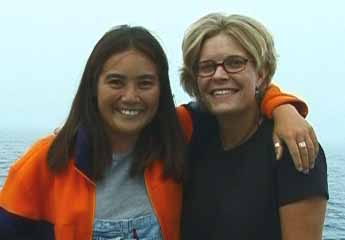
June 22, 1999
Day 2 of NeMO Cruise!
Hi there! We've been sitting atop Axial Volcano for almost a day now and are anxiously anticipating our first dive to the sea floor. The remotely operated submersible ROPOS is ready for deployment, and once the high temperature vent fluid sampler (photo below in teacher log) is ready we will head on down. So, what will we see a mile below the surface? We have some guesses, but until we reach the bottom no one knows!
You may already know that in January of 1998 Axial erupted and spewed miles of new lava onto the southeast portion of the caldera (the depression at the top of the volcano). Last summer, we were very excited to find new hydrothermal vents on the new lava flow. Only a few months after the eruption, these vents were already colonized by vent fauna. We found numerous tube worms, snails, limpets, scale worms and crustaceans at more than 10 vents over 2 miles of new lavas.
Our lab studies the ecology of vent communities. We are very interested in understanding how hydrothermal vent assemblages are structured in space and time. This means we need to take samples of the fauna in order to find out what species are where and how many. Usually we do this by taking tube worm grabs with the robotic arm, or we suction up animals in a vacuum cleaner operated by the sub. Last year we retrieved samples from many new vents. One of our goals this year is to go back to those same vents and take more samples to get an idea of how the communities have changed in the past year. We HOPE the vents are still there!! If not, plan B comes into action we'll keep you posted.
One thing we can do if the vents are no longer active is look at how dying communities are organized. This is actually pretty #*$%@ing cool because in many biological systems the research time-scale (or life-span of the researcher!) is typically shorter than the duration of the system. So we get to study the community from it's birth to it's death.
We are very excited to be out here because there is only a short window of opportunity to do our fieldwork. Weather constraints limit cruise season in the northeastern Pacific from June to September, and money constraints usually mean that cruises are only 2-4 weeks long. That means we have to get all our data in a very short period of time! This year we have 3.5 weeks to gather all the data for the upcoming year. So, keep your fingers crossed for us - hope for good weather and keep checking out the daily reports to find out if last year's new vents are still active and crawling with critters!
June 21
Bob Embley
NOAA Vents Program, Newport Oregon
NOAA Vents Program, Newport Oregon
PERSPECTIVE ON NeMO 99
Bob Embley For more information:
Credits/Contacts
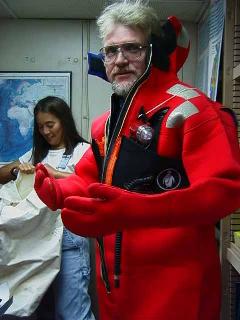 Hi, I'm
Hi, I'm
oar.pmel.vents.webmaster@noaa.gov
